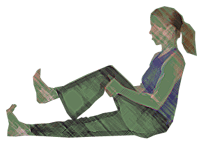From the Bihar School in northern India and the great teacher Paramahansa Satyananda come the Pawanmuktasana sequences. This series of exercises is recommended as preparatory work before going into any other asana practice, either yin or yang. The series opens up the joints, relaxes the muscles, and promotes general health.
 These exercises can be practiced by anyone: young, old, those in good health, and those in poor health. The exercises should be done in a relaxed state of mind; they are actually more mental than physical. As you will discover, these are not challenging postures, but they should be respected due to the great value they bring. [1]
These exercises can be practiced by anyone: young, old, those in good health, and those in poor health. The exercises should be done in a relaxed state of mind; they are actually more mental than physical. As you will discover, these are not challenging postures, but they should be respected due to the great value they bring. [1]
Pawan means wind. Mukta means release. Asana, of course, means pose or posture. Thus, the Pawanmuktasana sequences are designed to release the flow of energy, and remove any blockages that prevent its free flow in the body, or in the mind. Continued practice of these sequences can prevent new blockages from forming. These move-ments are excellent for people suffering from rheumatic arthritis, high blood pressure, or for people with heart problems who are advised to avoid vigorous exercise.
Dr. Motoyama, in the book Theories of the Chakras: Bridge to Higher Consciousness, suggests that the Pawanmuktasanas be performed before any other asanas. He explains that they are part of the preparatory work of awakening the chakras.
In the book Asana Pranayama Mudra Bandha by Swami Satyananda Saraswati, we are given three series of Pawanmuktasanas. Dr. Motoyama basically follows the first of these, with some additional movements. We will be exploring his version in this section; however, interested readers can check out Satyananda’s book.
Dr. Motoyama recommends, before doing any of the Pawan-muktasana, one should begin with Shavasana. Paul Grilley also suggests this. Shavasana, before asana practice, relaxes the body and allows the energy to be more easily distributed and absorbed. If you are used to doing Shavasana only at the end of your practice, you may want to experiment with doing it at the beginning and the end, and even for a brief time between postures.
While you work your way through these movements, slow down. It is easy to move quickly, because they are so simple. Move with your breath, and breathe with awareness. Watching the breath will slow you down.
(Next: Lower Body Pawanmuktasana )
